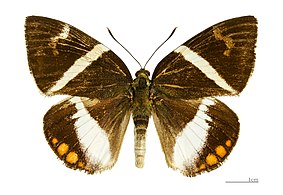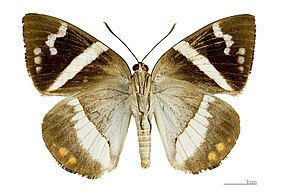| Telchin licus | |
|---|---|
 | |
| T. l. insularis, Trinidad | |
 | |
| Scientific classification | |
| Domain: | Eukaryota |
| Kingdom: | Animalia |
| Phylum: | Arthropoda |
| Class: | Insecta |
| Order: | Lepidoptera |
| Family: | Castniidae |
| Genus: | Telchin |
| Species: | T. licus |
| Binomial name | |
| Telchin licus (Drury, 1773) | |
| Synonyms | |
| |
Telchin licus, the banana stem borer, is a moth of the Castniidae family. It is native to South America, where it is found from Colombia, Venezuela and the Guianas, throughout the Amazon basin in Brazil and Peru. It has also been recorded as an introduced species in Hawaii.
Contents
The length of the forewings is 64–80 mm.
The larvae feed on Saccharum officinarum , Musa , Heliconia and Ichnosiphon species. It is considered a pest species. Young larvae make a small cavity and then tunnel into the heart of the cane of the host plant. They tunnel upwards and downwards, and create a shelter in the rootstock where they rest. Pupation takes place in the rootstock or at the base of the cane. [1]

